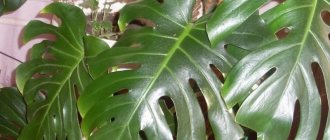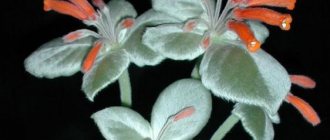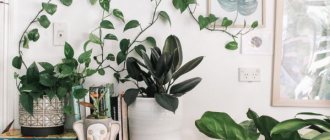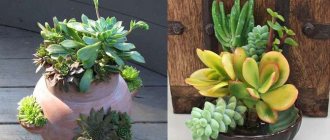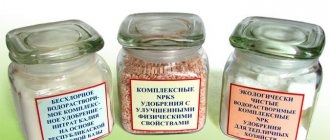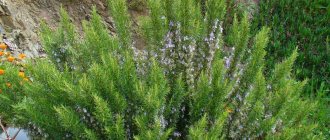Croton is narrow-leaved with the longest leaves. Indoor plant species and varieties
A single species, Codiaum variegatum, as well as its varieties and hybrid varieties, began to be grown as indoor plants.
But they represent such a wealth of shapes and colors that other types were simply not useful. Varieties of Codiaum variegatum:
- The narrow-leaved croton is equipped with long (about 20 cm) leaves, their width is no more than 1 cm. Yellow-golden strokes and specks are scattered across the green background.
- The appendage-like croton is variegated and green. Its leaves, wide at the base, narrow in the middle into a kind of petiole, and then expand again, forming a small leaf appendage at the end.
- Curly codiaum (crispum) has long, narrow, curled leaves. The greenery has stripes, spots, veins or a network of different shades of yellow. The brightest representative of the variety is Spiral with uniform turns of leaves.
- Lobed croton is distinguished by wide leaves divided into three parts. The central lobe is much longer and wider than the lateral ones. Yellow veins decorate the bright green of the leaf.
- Flat-leaved (platyphyllum) codiaum is a plant with large (up to 30 cm in length and 10 cm in width), oval leaves, their edges are slightly wavy.
- Oval-leaved (ovalifolium) with simple leaf blades in the shape of an elongated oval with a rounded end, rich yellow markings located along the veins.
- The tortoiseshell variety (tortile) is distinguished by leaves that are broad at the petiole and taper towards the tip. On an olive green background there are red and yellow stripes along the central vein and chaotic golden spots.
- Genuinum is a variety with solid oval leaves covered with a pattern of silver or gold color with a reddish tint. There are forms with small and ribbon foliage.
- Codiaeum variegatum pictum is the original form for most hybrid varieties. This is a shrub with a straight stem (up to 1 meter in height), which is covered with dense and hard leaves. They are painted with a pattern of bright yellow, red, pink spots on a green field.
Description
Tall indoor plants: name, description with photos, use in home landscaping and care features
The plant has an erect, powerful stem (length from 35 to 70 cm and above). But its real decoration is the leaves. They are large, dense, have different shapes and colors.
It depends on the specific type. For example, a narrow linear shape is found in varieties Gold Star, Pictum, Petra is famous for its oval shape, Excelent leaves look like a trident, and Golden Ring has an elongated and wavy shape.
Young specimens have mostly green leaves. Over time, they turn all sorts of shades of yellow, red and orange. Lemon combines whimsically with pear, wine, raspberry and copper. Everyone will find their favorite shade in this indoor flower.
Croton codium angustifolia. Variegated codiaeum (Codiaeum variegatum) Variegatum
The ancestor of all cultural species of Codiaums. In nature, it grows either as a shrub up to 1.5 meters in height, or as a four-meter tree with smooth branches and leaves located only at the ends of the branches. At home it grows up to half a meter.
It has large, up to 25-30 cm leaves, arranged alternately. The leaves are leathery and dense. Has a wide variety of colors. It grows slowly. Through selection, various species with different leaf shapes have been bred from it. In this codiaum they are initially oval in shape, the leaf blade is even.
Croton variegated
Varieties of Codiaum motley:
- Genuinum - leaves with smooth edges, flat, oval or lancet-shaped, with pointed tips at the base and tips. On the upper side of the leaf, along the central vein, golden patterns are visible. There are species with a reddish tint to the initially growing leaves;
- Decorated (picturatum) - the leaves are narrower, closer to lanceolate, the color is approximately the same as the previous variety;
- Tortoiseshell (tortile) - the leaf plate is heart-shaped at the base, then elongated with a pointed tip, twisting slightly around its axis. The color is variegated: a red central vein and a golden stripe stand out against a green background. On both sides of the sheet there are irregular spots of the same color;
- Trilobate (trilobium) - the base of the leaf is deltoid. The leaf plate itself is divided into three parts. The color of the leaves is very diverse - from stripes of different colors along the veins, to different colored spots or a combination of both;
- Wrapped (volutum) - broadly lanceolate long leaves curled towards the base. Over time, the plant takes on the shape of a ball and looks very original;
- Narrow-leaved (angustifolium) - linear narrow leaves reach a length of 25 cm with a width of 0.5 to 1 cm. Veins and random spots located on the leaves can be colored yellow.
- Appendiculatum Celak. – Distinguished by the unusual shape of the leaves. The broad oval plate at the apex narrows to a vein and then expands again, forming, as it were, a second leaf.
Difficulties in growing
All difficulties that arise when maintaining croton are in one way or another related to the mistakes of the grower. What exactly the problem is can be understood by the plant’s reaction. For example:
- Falling leaves indicate a violation of the temperature regime (hypothermia, draft, temperature difference). It must, however, be borne in mind that seasonal shedding of foliage, especially its lower and older parts, is the norm for codiaum;
- the absence or disappearance of bright colors is a consequence of lack of lighting or excess nitrogen fertilizers;
- small and deformed leaves , on the contrary, indicate that the plant needs to be fed;
- brown spots on the leaf blade appear if the flower is exposed to direct sunlight, but if the darkening is located along the edges of the leaf, this may indicate hypothermia;
- Drying leaf tips are a sure sign of insufficient air humidity. If the problem is not solved, the leaves will begin to fall;
- black plaque on fabrics is a symptom of a fungal disease called black fungus or sooty fungus. The development of infection is facilitated by stagnation of water in the soil. It is treated by removing the affected areas and using fungicides containing copper (Strobi, Skor, Flint, Horus, Ditan M-45 and others).
Croton's poisonous sap usually repels pests, but a weakened plant can still be attacked by scale insects, thrips, nematodes, mealybugs or red spider mites.
Find out what to do if your croton is dropping its leaves.
The best prevention of parasite damage is regular treatment of the leaves with a moistened sponge, as well as spraying: at high humidity, the healthy immunity of codiaum is able to cope with the problem on its own.
Croton pictum angustifolia. Botanical description of the plant
Croton (Latin name Codiaeum) is a perennial evergreen plant of the Euphorbiaceae family. In nature, it is found in tropical and subtropical forests of Australia, Oceania (Polynesia), India, as well as some islands of Southeast Asia (Malaysia, Philippines, etc.). Due to the amazing colors of the leaves, the flower is sometimes popularly called “Joseph’s Cloak.”
Did you know? Codiaum is the original name of the plant, probably coined by its discoverer, the Dutchman Georg Rumphius, who studied orchids on the island of Ambon in Indonesia in 1654 and saw the original shrub there. Local residents called the perennial with the beautiful word “kodibo”, although today “codiaum” is rather associated with the Greek “codeia”, which means “head”.
Despite the fact that the plant came to Europe in the second half of the 17th century, the real fashion for it began only three hundred years later. Together with Dieffenbachia and Dracaena, croton initially began to be grown by flower growers from the Netherlands, and from there it began to conquer the world.
When describing the botanical features of codiaum, it is necessary to highlight the following main characteristics of the plant:
| Maximum dimensions | 50–150 cm (in the wild - up to 300 cm) |
| Root system | Powerful, fast growing |
| Stems | Dense, erect, with a large number of lateral processes |
| Leaves | Petiolate. The structure is dense and leathery, with a beautiful gloss. The sizes are large (up to 30 cm in length). The shape can be different (lanceolate, three-fingered, oval, lobed, carved, spiral, often flat, but sometimes with wavy edges). A distinctive feature is a bright and bizarre color: against the main background of any shades of green, there may be stains, veins, stripes, inclusions and other fragments of yellow, white, purple, pink and other contrasting or nuanced colors |
| Inflorescence | Racemose (panicle) |
| Flowers | Small, undecorative, white, yellow or beige with long protruding anthers |
| Fruit | Box with large seeds inside |
Important! Like other Euphorbias, codiaum is poisonous. It is not advisable to keep such a flower for people who have pets (primarily cats). Also, croton juice can cause serious irritation on the skin, so pruning and replanting the plant should be done with protective gloves.
An interesting botanical feature of codiaum is the ability to change the color and shape of leaves depending on environmental conditions. It is on this amazing property that active breeding work aimed at developing new varieties of decorative flowers is based.
Diseases
Despite the fact that the croton looks quite impressive in appearance, if the wrong approach to ensuring its vital functions is taken, it may well become ill.
Leaves dry and wither
If the croton's leaves begin to dry out and subsequently fall off, this means that it has not been properly cared for. Basically, this symptomatology is characteristic of low room humidity and lack of the required amount of light, as a result of which mites may appear. To eliminate the problem, the microclimate is normalized and the codiaum is processed.
It is also possible for the disease to manifest itself if the interval in replanting is too long, which is required annually due to the active growth of the plant. The ideal pot should be quite wide, but shallow and with mandatory drainage made of broken brick or expanded clay.
The leaves come down and start to fall
In this case, there is no need to always panic. Loss of turgor may well be a natural process associated with the age of the flower and is not a bad omen. This mainly applies to foliage located on the lower tier. It is normal for these croton plates to dry out.
If the problem is large-scale and the plant is still young, it is worth reviewing the conditions of its maintenance. The appearance of the disease is mainly associated with a lack of light, excess moisture, or sharp fluctuations in room temperature.
The reason may lie in a violation of the functionality of the roots. In most cases, this is the result of overwatering, and to solve the problem, the bush should be replanted, checking for rotten root shoots, which are delicately removed. The optimal method for culture is considered to be the transshipment method.
Dull color
Loss of color is associated with insufficient or incorrect feeding. To change the situation, you should fertilize the tree with a mineral composition with a high nitrogen content.
Now you know everything about croton and how to care for it at home. Having learned to propagate this plant, you can easily recreate mini-tropics in your home, plunging into which you will take a break from everyday worries. Despite the relative harm from the milky sap, do not be afraid to purchase a plant if you really like it. You can buy it in any specialized store and in some supermarkets during the New Year holidays. Growing codiaum in an apartment is easy, and its features make the green pet only more interesting and each individual unique.
Croton angustifolia propagation by cuttings. Croton propagation methods
Nowadays, florist shops delight amateur gardeners with an abundance of indoor plants. There are palm trees, cacti, exotics with bright flowers and spicy aroma, and even amazing and dangerous insectivorous plants. Among the wide selection of indoor plants, croton occupies not the last place. The article will discuss how you can propagate this interesting flower at home.
Description
Croton is a perennial, its colors similar to the riot of colors in the autumn forest. This comparison is not accidental - on the leaves of croton you can see green, yellow, and red. Croton blooms rarely; the flowers are small, pale yellow, collected in clusters, with a light honey aroma.
Croton belongs to the Euphorbiaceae family. It grows naturally in southeast Asia and can grow up to 3 meters in height. In captivity, croton grows to a maximum of one and a half meters.
It should be said that croton is a capricious plant, and caring for it is not so easy. However, it is beautiful and can decorate any interior.
How to propagate?
There are 4 ways to propagate croton. Let's list them, and then consider each in more detail:
- cuttings;
- seeds;
- leaves;
- layering.
Let's look at each method step by step.
Cuttings
Probably the most popular way. To implement it, it is necessary to select mature cuttings from 8 to 15 centimeters long, cutting them from the “head” or side trunk of the croton. It is best to carry out the procedure in the spring, when daylight hours will increase and the sprouts will be able to receive enough light for full growth and development.
Although, if it is possible to use phytolamps, you can propagate croton all year round.
Let's look at the step-by-step procedure for propagation from cuttings.
- Prepare the shoot, cut off all its lower leaves, wash off the milky juice released at the cut site, thoroughly blot the “wound” with a paper napkin and sprinkle it with crushed activated carbon. Let the cutting dry a little, at least 2-3 hours.
- Tie all the leaves remaining on the shoot into a tube, and if there are large leaves left on top, cut them in half so that the “baby” croton can retain moisture inside.
- Prepare the container in which you will grow the “baby”. Pour a drainage layer there (for example, expanded clay), then fill it with a sand-peat mixture. Plant the cutting there, cover the top with cellophane with small holes made (for “breathing”) and place it in a warm place where diffused light reaches.
- After a month, you will see that the cutting has begun to grow. This propagation method is suitable for all varieties of crotons. The “parent” flower, after cuttings, as a rule, soon produces new shoots.
There is another method of growing cuttings - using water. Let's consider it.
- We take settled water with a temperature no lower than room temperature (optimally 26 degrees above zero) and place the “baby” in it.
- After the white roots appear and reach a length of 3 centimeters, we transplant the sprout into a container with the mixture mentioned above. Cover with cellophane.
- Be sure to monitor the ambient temperature. It should not fall below +23 degrees and rise above +28. But we also adjust the lighting - it should be diffused light, soft, without direct burning rays. Provide the croton with long daylight hours - at least 12 hours. If necessary, “extend” it with the help of a phytolamp.
- After 30-35 days the sprout will take root. Transplant it into a small pot with a drainage layer and nutritious soil mixture. After the croton begins to grow and its roots fill the container, transplant the plant into a pot larger in diameter - about 15 centimeters.
Seeds
Another way to propagate croton is using seed material. For planting, only freshly harvested seeds are used, as they very quickly lose their viability. Seed propagation is carried out in winter (late January - early February).
Let's look at this process step by step.
- First of all, immerse the seeds in an aqueous solution of phytohormones for about 2-3 hours. Some amateur gardeners simply soak the seeds in very warm water (60 degrees Celsius), keep them there for 30 minutes, and then leave them to swell for 24 hours.
- We sow the seeds in a prepared seedling box or any other similar container. Sowing depth is 10 millimeters.
- We put the box in a warm place (the optimal temperature is 21-23 degrees above zero) and cover it with cellophane or glass. We make sure that the top layer of soil is always moist.
- After 30 days, the seed material sprouts. When each of them produces 3 leaves, they need to be planted in different pots of small diameter - 5-7 cm.
- They care for small crotons in the same way as adults: water, spray, ventilate the room in which they are located, provide diffused lighting and warmth.
Lighting and temperature
Maintaining the required temperature and proper lighting are the basis of home care
The indoor croton flower differs from other crops in the stunningly bright color of its leaves, which attracts the attention of gardeners to it. In order for the bushes to delight with their variegated color, they must be placed in a well-lit place
It must be remembered that with a lack of light, the plant loses its unique decorative effect. But at the same time, in summer, crotons need to be shaded from direct rays. The leaves of the crop only seem tough. However, from the sun they quickly develop burns that look like spots. In winter, the plant can be placed on a south window. If you organize your care correctly, the croton flower will certainly delight you with its beauty.
It must be remembered that the homeland of codiaum is the tropics, so the culture is heat-loving. Correct temperature conditions are an important component of home care. The croton flower is demanding on the air temperature of the room in which it is located. The optimal temperature for the crop is +20…+22 degrees
Please note that the temperature should not fall below +16 degrees. In summer, bushes can be placed on the balcony or taken out into the garden, providing protection from the wind and scorching sun rays
Croton angustifolia care at home. Secrets of caring for codiaum at home
Caring for decorative perennials is not too difficult, especially for the most unpretentious varieties and species. The main conditions for proper cultivation are the use of high-quality nutrient soil, comfortable temperature conditions, optimal humidity levels and timely pruning of the above-ground part.
Requirements for soil and planting pot
Codiaeums grow and develop well in the presence of loose and well-fertilized soil. Purchased soil for flowering ornamental and deciduous plants is optimally suited for this purpose. When preparing it yourself, you should mix an equal amount of turf, leaf soil, peat chips and medium-grained sand.
The soil mixture is pre-frozen or calcined. Drainage based on expanded clay or clean pebbles must be poured into the bottom of the flower pot. The pot for growing a young plant should be of medium size. The flower pot should not be deep. An adult plant is grown in larger pots and flowerpots.
Optimal growing conditions
The heat-loving crop grows and develops at a temperature of 21-25°C. It is necessary to protect the plant from drafts and cold winds. In summer, the plant should be protected from direct sunlight to avoid burns of the foliage. East or west windows are best suited for placing a flower pot. In winter, you can place an indoor flower on a sunny southern windowsill.
Insufficient lighting negatively affects the decorative appearance of the plant - the foliage loses its bright color and becomes uniformly green. Croton loves bright, but fairly diffuse lighting and high humidity. The foliage should be wiped on both sides with a damp cloth. Once a week in the morning, spraying is carried out with warm and settled water with the addition of growth stimulants “Zircon” and “Epin-extra” or “Immunophytophyte”.
Location
Croton is a light-loving plant, and the variegated color of its leaves largely depends on the lighting.
But prolonged exposure to direct rays is contraindicated for the flower. Therefore, when providing proper care for Croton at home, focus on the weather and time of year. In spring and autumn, an eastern or western window sill will be the ideal place for a flower. In summer, move the pot to the northern part or move it deeper into the room. In winter, on the contrary, place the flower on a southern windowsill or illuminate it with a phytolamp.
Croton needs fresh air. At any time of the year, do not forget to ventilate the room, but protect the flower from drafts - it absolutely cannot stand it. Therefore, during ventilation, take your pet to another room. In summer you can keep the plant on the balcony. But choose a place with diffused light for the flower.
Codium croton angustifolia. Croton - species with photos and names
Codium variegated is grown at home. Common varieties:
- Codium Sunny Star. Leaves with a tapered end. Young foliage is light green with bright yellow streaks.
Croton Sunny Star
- "Aucuboleous". Foliage is unevenly colored. There are yellow and green tones. This croton is narrow-leaved.
Codiaum aucubifolia
- Codium Vilma - multi-colored asymmetrical yellow-green leaves.
Croton Wilma
- Petra. A flower with yellow spots on the leaves. Large bush with lateral leathery leaves. On the shoots they are located alternately.
Croton Petra
- Mammy. Flower with red veins on the leaves, narrow-leaved. If properly cared for, there are bright yellow, green, and pink tones. The edges of the leaves are slightly curved.
Mammy
- Codiaeum Disraeli. Lobed leaves of a brown hue. The outer side of the leaf blade has bright yellow spots and veins.
Croton Disraeli
- Codeium Excellent. The foliage looks like oak. There are clear green and yellow blotches and stripes on the surface of the leaves. The reverse side of the foliage is pinkish.
Codeium Excellent
- Zanzibar. Dense narrowed leaves of a bright green hue. There are orange, yellowish, burgundy stripes.
Zanzibar
- Mrs Eyeston. A compact tree or spreading bush with large green leaves grows. On the surface of the foliage there are pinkish, burgundy spots, and yellowish stains.
Mrs Eyeston
- Black Prince . Dark green leaves with red, orange spots and stripes.
Black Prince
- Nervia. Multi-colored greens - leaves of a yellow, pinkish hue. The edges are wavy. There is a central vein on the surface.
Nervia
- Croton Tamara. The tone of the oval leaves may be green. The edges are light green or white.
Croton Tamara
- Codium Gold Sun. Large variegated foliage. The main color is green, there are yellow veins. Height more than 30 cm.
Codeium Gold Sun
Codiaum Variegatum Mix is often sold. This is not one variety, but several. Codium Mix can be of different colors. It depends on the age of the crop and its growing conditions. Therefore, compositions with the same varieties often look different.
Kinds
The genus Codiaeum includes more than a thousand different plants, and it includes not only shrubs, but also trees. However, only one variety of croton is used as an indoor flower - Codiaeum variegatum, or variegated Codiaeum. In turn, within this species there are a huge number of different varieties and hybrids, including those bred through selection. They differ from each other in shape, size and color of leaves.
Read more about the types of croton.
So, in flower shops today you can buy the following varieties of croton:
- narrow-leaved (Angustifolium): leaves have a pointed shape, width does not exceed 15 mm, color - golden spots on a green background;
- appendiculatum: the leaves are oval, but in the middle part they have a narrowing, as if they are tied with a belt;
- curly (Crispum): leaves are narrow and wavy, very brightly colored;
- Mrs. Iceton: the leaves are wide with curled tips, painted with pink and burgundy spots, young plants have cream-colored splashes. Can be shaped like a neat tree;
- Zanzibar: narrowed, decoratively curved and very dense leaves, painted with purple, yellow and orange stripes on a green background;
- Excellent: the leaves are shaped like oak leaves, the color is an interlacing of spots and stripes of green and yellow shades, in the lower part they can be burgundy;
- Petra: Leaves are oval, pointed or lobed, yellow on the edges and yellow mottled in the center. The plant itself branches well;
- Disraeli: leaves are lanceolate, bicolor - green at the bottom, burgundy at the top;
- Splashes of champagne: leaves are narrow, green in color with small yellow spots;
- Mammi: distinguished by a wide variety of both the shape of the leaf blade (elongated, twisted, wavy) and its color;
- Tamara: light edging in the form of spots on medium-sized leaves;
- Nerve: jagged edges on long leaves with bright, multi-colored colors;
- Gold sun (Gold sun): the leaves are oblong, narrow at the base, the plant itself is quite large and spreading;
- draco: an American variety of croton, the main value of which is a very valuable red resin, widely used in medicine and the chemical industry;
- thorny (echinocarpus): a variety very similar to dragon fruit, distinguished by the presence of thorns on the fruit capsule;
- Cascarrolla (Eluteria): another variety of medicinal croton, it is also one of the few varieties whose flowers look very decorative and, in addition, have a magnificent aroma (the word “cascarrolla” is translated as “bark”, the variety received this name due to the fact that it is its bark that has numerous medicinal properties);
- laxative (tiglium): green leaf blade, valued for the oil contained in the seeds and which has a pronounced laxative effect;
- Norma: the leaves are large, initially yellow-green, and as they form - red-green;
- Baron J. De Rothschild: distinguished by its brightness and variety of colors, which can include orange, pink, yellow and green in different shades;
- Gold Star: leaves are long and narrow, united into star-shaped rosettes, green in color with yellow mottling;
- Appleleaf: distinguished by red edging on the foliage;
- Gold Moon: leaves are decorated with yellow stripes.
Croton angustifolia propagation. How to propagate croton by cuttings and leaves at home
You can’t even imagine how exciting the process of croton propagation can be! I had no idea about this before. Until one day I had a cutting of this beautiful plant in my hands.
It's all because of my curiosity. But the process fascinated me so much that today, thanks to my efforts, crotons grow in all my friends. And every single one of them is happy about such a gift.
This unusually bright plant with large, catchy leaves is liked by many gardeners for its ease of cultivation and propagation. After all, in the end, without putting in a lot of effort, you can get a luxurious plant that will delight you with many beautiful shades of foliage.
The plant is very decorative; in natural conditions it reaches a height of three meters. At home, this deciduous plant can grow up to one and a half meters in height. As an indoor crop, croton is grown for its beautiful variegated leaves that have a wide variety of shapes.
Moreover, it is known that the plant has a beneficial effect on the nervous system and can calm and improve mood. Its leaves disinfect indoor air, which is especially important in dusty and polluted urban environments.
Description
In nature, croton is found in the tropics of India and Southeast Asia. The second name for croton is codiaum, which comes from the Euphorbiaceae family. Translated from Greek, the word codeia means head. A little unclear, but nonetheless a fact.
It is distinguished by its oval, slightly elongated shape of leathery, dense leaves. Leaves of various shapes have a wide variety of shades.
Croton is also popularly called indoor oak; it can have not only variegated leaves, but also light green, yellow - very different hybrid varieties have been bred by breeders.
A characteristic feature of croton leaves is the ability to change the color of the foliage, but not at all due to the change of seasons, but everything depends on age-related changes. Codiaum blooms with completely inconspicuous, small flowers; it is better to remove them due to the lack of decorativeness, but croton did not waste energy on their development.
The developed varieties of croton differ in leaf shape:
- appendage - a leaf of green or variegated color, has a bridge, consists of two parts.
- lobed - the leaves have a three-lobed shape, the middle part is somewhat elongated, up to 20 centimeters, has stripes and spots.
- flat-leaved - large oval leaves have wavy edges.
Kinds
Codiaum variety Mammi
It has narrow and small leaf blades, their edges are smooth and wavy. The leaves curve along the central vein. The color of croton can be completely different; even on one specimen you can find leaves of both red and green with pink and yellow spots.
Codeium Excellent
This croton has leaf blades shaped like large lobes. The color of the leaves is green with yellow veins. The inner side of the leaf is red and has brownish veins.
Croton Mrs. Eyeston
Croton Mrs. Iceton has leaf blades that are quite wide, but short. On younger plants the foliage is a soft cream color.
As they get older, the leaves change color to pink or bright red with lots of splashes of yellow. In some specimens you can see leaves of a very dark, almost black color.
Codium Mix
This type of croton is distinguished by the presence of a mass of subspecies. It has pointed, long leaf blades that grow up to 20 centimeters. There are even varieties with 30 centimeter leaf blades.
Croton Sunny Star
Its leaf blades are green, and the tops themselves are yellow. The leaves have a slightly pointed, lanceolate shape. Young leaves are bright green with yellow veins.
Codiaum aucubifolia
It is very popular among gardeners for indoor growing. The leaf blades are unevenly colored, with yellow-green tints. The leaves are medium sized, rather narrow.
Croton: description, reproduction and care,
Propagation of codiaum using cuttings
With this method of propagation, a lot will depend on the chosen cutting itself; you need to decide which part of the plant to take the cuttings from and what time to choose for this.
All months are suitable for propagation, with the exception of January-February, since this is the resting time for the plant. Rooting of cuttings during this period will be weak, or may not occur at all.
The best time to root cuttings, of course, is spring.
Planting and transplanting
Adult plants are rarely replanted - once every 2-4 years as needed, when the roots have completely entwined the earthen ball. Large crotons are transferred to another container, but more often they simply replace the top layer of soil with a new fertile one. Another thing is young plants that have not reached 3 years of age. They require annual transplantation, which is carried out in the spring - in March or April.
Priming
For planting or replanting, you will need slightly acidic soil, well-drained and air-permeable. You can buy universal soil in the store and add drainage of the finest fraction, perlite and pieces of charcoal to it. Or you can prepare the soil mixture yourself. You don't need a lot of time or special skills. And the composition of the soil does not differ in exotic components. For young plants you will need:
- 2 parts leaf soil;
- 1 part of turf land;
- 1 part coarse sand.
For adults - you need to take 3 parts of leaf soil, and leave the proportion of the remaining components the same.
planting pot
Choose a pot based on the size of the plant. The larger the croton, the more stable the planting pot should be. For small plants, plastic containers are quite suitable. For large ones, try to choose a clay container. Another advantage of ceramics is that the material breathes, which means the earthen lump inside the pot will not mold. The dimensions should be several centimeters larger than the previous one, moderately wide, but shallow. If you take a container for growth, then do not expect rapid growth after replanting - the croton will try to master the inside of the pot, and will completely forget about the leaves.
For planting croton, you can choose a pot from any material, but ceramics is still preferable
A new pot must have drainage holes. And please don’t forget about drainage.
Step-by-step replanting of croton
- Croton does not like the destruction of the earthen coma - it is replanted only by transshipment. To ensure everything goes well, water the plant an hour before the procedure. Water will nourish the soil, make it denser and it will not fall apart when transplanted.
When transplanting croton, try not to destroy the earthen ball
- While the water is being absorbed, prepare the planting container. At the bottom - drainage, a layer of at least 3 cm, then soil mixture.
- Carefully remove the plant from the old pot, place it in the center in a new container and add soil to the sides.
- Place the watered plant in a place that is lit but protected from direct sun. Spray daily.
Only healthy plants are replanted!
Store-bought croton must undergo an acclimatization period. You can spray with Epin solution to help adapt to a new place. If the plant is healthy, then replanting can begin in 3 weeks.
Croton does not need supports, as it has a fairly strong stem. But if the plant develops in unsuitable conditions and its stem bends and lacks stability, then a bamboo support to which the plant is tied can help.
A properly grown croton has a fairly strong trunk and does not need support.
Care
Maintaining codiaum and caring for it at home will require time and effort. This is not a plant that is only watered once a week and forgotten until the next procedure for moistening the soil. In order for the capricious exotic to look luxurious and delight the eye with a riot of colors, caring for croton should include the whole range of actions:
- selection of a well-lit place;
- ensuring high humidity in the room;
- regular washing and wiping of leaves;
- watering the plants, fertilizing, replanting;
- pruning dried shoots and flowers;
- pest and disease control.
To understand how to care for them at home, you need to imagine the microclimate in which croton grows in its natural environment, and try to get as close to them as possible. Read here how to preserve the natural beauty of flowers and herbs.
The soil
Codium croton grows well in nutritious, loose soils.
In heavy soil, moisture stagnates, the roots rot and the plant dies.
You can independently compose a soil mixture from turf, leaf soil, peat and sifted river sand taken in equal parts. If you use store-bought soil for home crops, be sure to add sand to it. This way the roots of the indoor croton plant will actively receive oxygen.
Lighting
This is one of the most important conditions for a croton flower. Care at home often becomes problematic due to the short daylight hours in most regions of the country. This is especially acute with the advent of the off-season and winter. In the plant’s homeland in the tropics, daylight hours last for at least 12 hours, the sun is bright, and the leaves of varigatum protect other, taller trees and shrubs from burns.
At home, you will have to install phyto-lamps for illumination in the fall and winter. It is better to choose windows with western or eastern orientation. On the south side, croton leaves will have to be covered for a couple of hours from the scorching rays.
The crop needs bright light to form spectacular multi-colored patterns on the leaf blades, but direct sunlight can leave burns on the leaves.
Temperature
Croton variety "Mrs. Iceton" and variety "Tamara"
It is very difficult to choose the right place for codiaum. Dry air is contraindicated for it, so placing it on window sills under which heating radiators operate is not the best option. On the other hand, croton reacts to any downward change in temperature. Variegated croton sheds its leaves as soon as it feels cold, so you can’t keep the plant on drafty windowsills. The optimal air temperature in the room should be +22-+24 degrees. The thermometer reading +16 is critical.
Humidity
In the question of how to care for croton, humidity is important as one of the prerequisites. It should always be within 70-75 percent, which is very difficult to achieve in a heated room in winter. Experienced flower growers advise using electric humidifiers. If it is not possible to purchase a device, you can use other ways to increase the humidity in the room:
- place the pot with the plant on the tray, after filling it with pebbles and pouring water;
- Spray croton leaves more often from a spray bottle with water at room temperature;
- Place the codiaum next to aquariums or indoor fountains.
Wipe the croton leaves with a damp cloth at least twice a week. This capricious beauty does not tolerate dust. Give it a “shower” 2-3 times a month, placing it in a bath and watering the leaf blades.
Watering
If the croton flower is not cared for correctly, it begins to hurt and parasites appear. Exotic plants should only be watered with settled, clean water at room temperature. Watering should be moderate.
By flooding the roots and excessively waterlogging the soil, you create all the conditions for the appearance of gray rot.
If this happens, root treatment and replanting will be necessary. Drying out of the earthen coma leads to the appearance of harmful insects.
When planting croton, drainage must be installed. For drainage, you can use polystyrene foam, ceramic shards, expanded clay, and small pebbles.
Fertilizer
Fertilizers and plant nutrition
It is important not only to know how to care for croton, but also to feed it on time and correctly. Special formulations will help the plant gain strength and look luxurious. Codium needs complex mineral fertilizers. Purchased formulations are perfect:
- Bona Forte;
- "Pokon."
They are diluted at the rate of 10 ml per 1 liter of water and applied to the soil after abundant watering so as not to burn the roots.
During the active growing season from spring to summer, fertilizing is applied twice a month; in winter, once is enough.
Bloom
Croton flowering at home
Only adult specimens bloom at the age of 3-4 years.
The flowering of croton is not impressive; they love croton not for its flowering, but for its bright green, red, black and blue leaves with expressive color accents. A flowering plant has no decorative value; on the contrary, faded, ugly, small flowers only spoil the appearance of the codiaum and take away its strength. They should be removed by cutting them off at the base of the peduncle with sharp scissors.
Trimming
To form a beautiful bush requires careful attention. Croton leaves are drawn to light and those that receive more of it grow large and bright. Therefore, the flower pot is regularly turned.
Active branching is promoted by pruning. It begins to be carried out when the shoots reach 15-20 cm in height.
The topmost shoots are pinched, stimulating branching of the lateral shoots.
The procedure can be carried out during croton transplantation, but keep in mind that the plant sap is poisonous, so you need to carry out all manipulations with it using rubber gloves.
Transfer
Croton is one of those plants that require mandatory drainage.
The root system of croton is very thin and intertwined, so you need to replant the crop carefully without damaging the roots.
To transplant croton at home, you will need a pot whose diameter is only 2 centimeters larger than the old one and fresh soil. If the pot size is too large, the plant will spend all its energy growing the root system rather than the leaf mass.
For those who do not know how to transplant croton, step-by-step instructions:
- 2-3 hours before transplanting, lightly moisten the soil in the pot with the plant;
- grab the base of the stem and turn the flowerpot over;
- carefully remove the plant along with the earthen lump;
- transfer it to a new pot, where a layer of drainage and some soil have already been poured;
- Place it straight and fill the voids with soil mixture.
Root system of an adult croton
Even if you did everything correctly and carefully, the croton will in any case have a hard time with the transplant. To help it adapt, water the soil with any store-bought root stimulant.
Diseases and pests
The exotic beauty is often attacked by harmful insects. This happens due to non-compliance with watering rules, temperature or humidity levels. Sometimes parasites are brought indoors with other indoor plants. Of the most common:
- spider mites - small spiders that cover the leaves with a thin web;
- aphids - white insects that attack leaves;
- Mealybugs are sucking small pests that leave a white, cotton-like formation on the leaf blades.
Insecticides “Aktellik”, “Intavir”, “Agrovertin” help fight pests.
The most common diseases of croton are anthracnose and root rot. The main reason for their appearance is acidification and excessive waterlogging of the soil.
